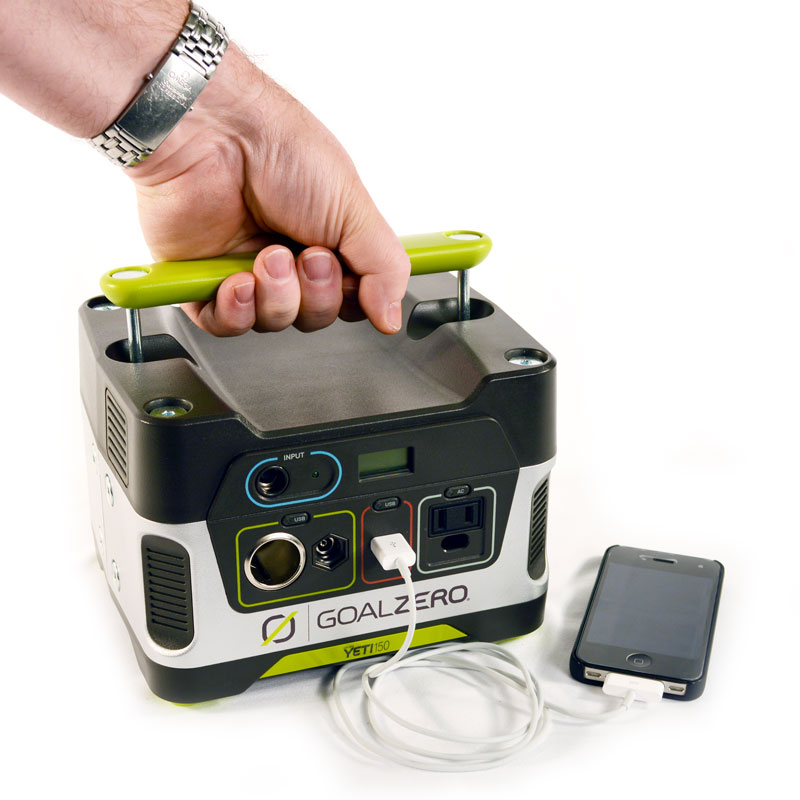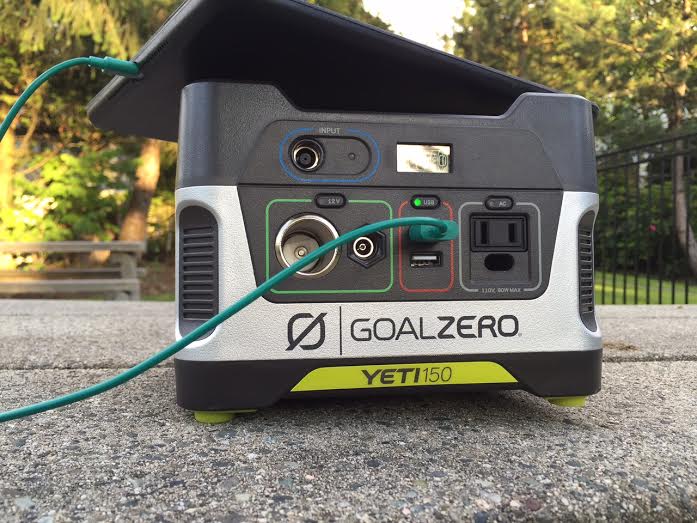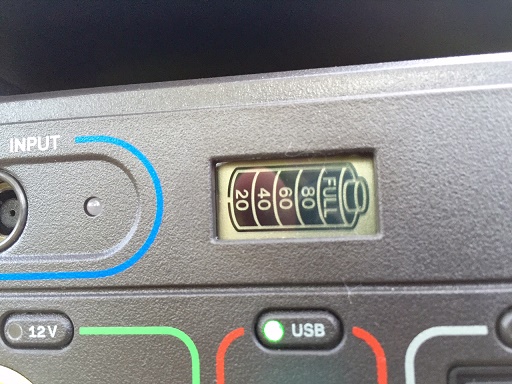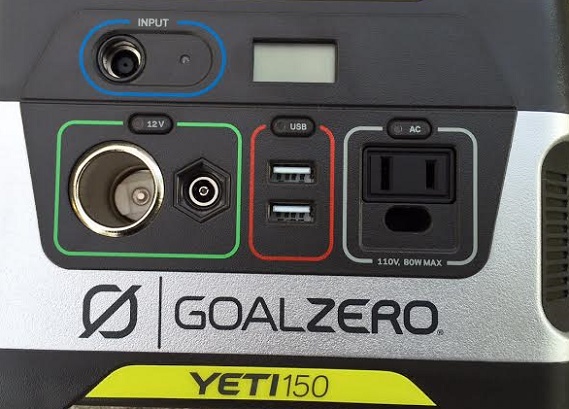
My fellow West Coasters! Do you remember the great power outage of 2015? The one that took place in the dead of summer in 25+ degree weather and left many of us without electricity for up to 4 days? It paled in comparison to what most East Coasters go through every winter but it taught me a fair bit about future planning. For example, I was using my car to charge my phone and was using my laptop very sparingly even though I needed to get a lot of work done.
One of the biggest problems many of us face with these types of things are that backup generators can tend to be really cost prohibitive. Thankfully, there’s a much easier and much more user friendly option. It’s compact and is available now. Meet the Goal Zero Yeti.
This review consists of my time with the Goal Zero Yeti 150 Solar Generator, the smallest model. The models available right now are as such:
Goal Zero Yeti 150 Solar Generator
Goal Zero Yeti 400 Solar Generator
Yeti is a fairly comprehensive experience. The 150 is only about the size of a car battery and is something you can stash away fairly easily. Whether you want to keep it in the car for emergencies, or take it with you camping, it will happily come along. Yeti can also be taken on a plane since the battery is sealed.
Yeti by name and by weight
The first thing you need to know about this thing is that with the various internal components involved, this thing is HEAVY. When you pick up the box, it feels like the weight is distributed well, but when you take it out, it feels almost like you’re toting a car battery around. Realistically, it only weighs somewhere between 10-15 pounds out of the box, but it feels heavier because the weight isn’t distributed outside of that small space.
Unlike other electronic products, it is not partially charged out of the box. You will have to charge it from a dead state. When plugged into your wall, it will take around 5 hours to do a full charge. Solar charging is around 17 hours for one panel. However, you can chain multiple panels together to bring that charge time down. Solar panels are not included with a unit out of the box (and are not a part of this review) but they are available separately. An adapter cable also comes with the Goal Zero Yeti if you have one of their older style panels to hook up to charge the newer product.
To keep the battery as fresh as possible, it’s recommended that you do a full charge on this every 3 months of inactivity. The overall product life for this is “hundreds” of charges. Given that I don’t think you’ll be using this all the time, I’d say that the product comfortably has an initial shelf life of 5-10 years, if not more. The Yeti’s battery is fully replaceable, however, which means that you won’t have a giant paperweight once it initially stops charging.

Instructions aren’t necessary
I mean, the Yeti comes with instructions, but you really don’t need them. In fact, the box itself throws out more facts at you than I ever would have expected packaging to do. Once you’ve read the box, you’re probably good. That being said, I quite liked the way the instruction manual was written. It’s one of the more conversational instruction manuals I’ve ever read combining all the technical information with easy to understand examples. It even discussed battery preservation strategies in length, which I really appreciated.
The Yeti minimized its power output by letting you select what you want to push power to individually. In order to start using a specific port, you just need to press the button associated with what you’d like to bring power to and then plug your device in.
The Yeti 150 itself comes with the following inputs:
- 12V input for standard “Cigarette Lighter” style plug-ins (120 Watt max)
- 12V 6mm Hex Port (120 Watt max.) This port is specifically designed for Goal Zero’s proprietary devices.
- 2 standard USB-in ports (10W max)
- 1 AC 110V wall outlet-style port (80 W continuous / 160 W surge)
A fully charged battery can provide life for the following actions:
- A 12 V light for 50 hours
- 15 smart phone recharges
- Between 3-6 tablet charges
- 2 laptop recharges or around 7 hours of continuous power
- Continuous stereo or radio power for 3 hours
While the smaller Yeti 150 can’t take on larger electronics (like TVs and fridges,) the larger devices like the Yeti 400 can.
The device has a small LCD screen at the top middle which shows off how much life is remaining on your current charge. The screen is asleep unless you turn one of the power functions on in which case it will display for as long as it is on.

The fastest charger in all the West?
Yeti won’t break any charging speed world records but it does a pretty darn good job. I’m pretty content with how fast it charged my iPhone 6 every time I put it on to charge. My laptop only charged slightly slower than plugged into the wall. I’d say that you won’t be disappointed by how fast this charges your devices. It’s not as fast as a USB charge from your computer or from the wall but it definitely gets the job done.
Is it Waterproof?
I hear you on this one. It’s the middle of June here in Vancouver and it was practically raining sideways earlier today. Rain is a pretty real danger to any outdoor or camping trip anywhere you are any time of year here on the West Coast. You may ask yourself – Is the Goal Zero Yeti waterproof? The answer is no. While the Yeti is water resistant, it is not waterproof or given any sort of IP rating. Really, what it comes down to is the fact that there are open ports on the front face of this and without any sort of carrying case or accessorizing plate available right now, you really shouldn’t think about ever leaving this thing out in the rain. Better yet, do not put this anywhere where it could submerse itself. You can probably pull it apart and try to dry out the elements, but there’s no “bowl of rice” trick that goes along with airing this out and you’ll do really quick damage to it. If you’re camping with your vehicle, I’d probably just keep this in the car at all times anyway since it’s a bit of a beast to tote around. If you’ve picked up a solar panel to help charge it, you can leave that outdoors. Though that isn’t 100% waterproof either, it’s definitely designed with the elements in mind so you’re less likely to do permanent damage.
 Do I need a Yeti?
Do I need a Yeti?
The Goal Zero Yeti is an endlessly helpful product to have in your proverbial back pocket though you’ve really got to figure out what you want to do with it. The Yeti 150 that I reviewed is probably more of a camper’s device. It won’t give you a lot of home options in the event of a power outage, and I suspect the major thing that you’d want to have protected during a power outage are cold goods. My camping days are behind me, so I’d be looking more toward the larger models in order to protect my fridge or deep freeze.
The best part about this is that it’s much more environmentally friendly than your standard gas generator. With no noxious emissions and the ability to recharge with solar panels, you won’t even need to plug it into a wall to charge (even though it’s 3 times faster that way.) The Yeti will definitely make a great addition to your camping, emergency or survival gear.




Great review of the Yeti from Goal Zero @paliontology
I like the possibilities this can create, especially here on the “Wet Coast”.
By interfacng this power supply to a Seagate Plus, among other devices and there may not be a need to go back home except to get more food for the camping recipes that @Shelly_Wutke suggested
camping recipes that @Shelly_Wutke suggested 
Comments are closed.